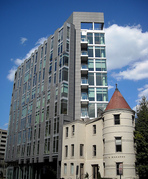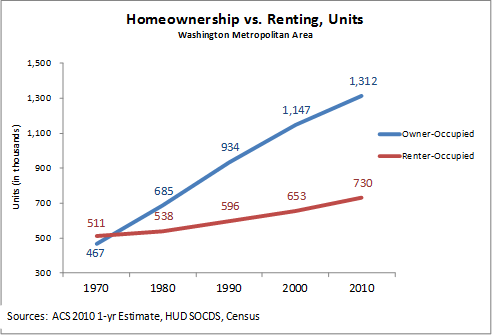DC area incomes fall behind skyrocketing housing costs

Photo by NCinDC on Flickr.
This is the first in a 5-part series about how the Washington metropolitan area can provide housing options for its growing workforce.
It’s no secret that the Washington area housing market is one of the most expensive in the country. With median home prices well above the national average and rents continuing to rise, finding affordable housing can be a challenge for area residents. It’s particularly hard when looking for housing close to jobs.
Housing costs have increased faster than incomes
Over the past 40 years, median home values and rents in the Washington region have increased much faster than household incomes. While the median household income increased by only 46% since 1970, rents rose by 69% and home values increased by 144%.
When a household spends 30% or more of its income on housing costs, housing researchers typically identify it as “housing cost burdened.” In 2010, about half of all renters in the DC region fell in this category, and 83% of renters with household incomes below $50,000 were burdened. Nearly one-third of the region’s homeowners spend more than 30% of their incomes on their mortgages.
On top of that, many so-called “drive to qualify” households, or those households that were only able to find affordable housing far away from where they were looking, have very high transportation costs. According to the National Association of Realtors Affordability Index, the Washington region ranks as the 5th least affordable major metro area overall, with only San Francisco, Los Angeles, New York, and Boston less affordable than our region.

Several factors have contributed to declines in affordability in the Washington area. Some are due to changing preferences of those that seek housing, or demand-side factors:
Population growth. The Washington region added 2.4 million people over the four decades between 1970 and 2010. Over the same period, household sizes were shrinking and more people were living alone which accelerated housing demand.

High-income households. These households created demand for larger and more expensive housing and builders rushed to meet demand. While overall household income growth has been relatively modest over the four decades between 1970 and 2010, a sizable share of the region’s workers earned very high wages.
The growth of the high-wage professional and business services sector began in earnest in the 1980s when federal procurement spending increased and the government contracting workforce expanded. Many of these jobs were high-wage jobs in engineering, computer programming, program management, and other fields that suddenly became the fastest-growing sectors in the region’s economy.
The workers in these fields benefited from high and rising salaries and demanded larger homes, more owner-occupied homes, and more expensive housing. Builders were happy to meet this growing demand, and as a result, the region saw fewer rental units and fewer smaller houses built over time.
Homeownership incentives. During the recent housing boom, easy mortgage financing and public policies that encouraged homeownership put upward pressure on home prices and fueled demand for higher-priced homes.
Speculation. Speculative demand by investors artificially boosted prices at the same time. Although values and prices dropped temporarily, Washington’s economy and job growth proved stronger than those in much of the country, and home prices rebounded, particularly in areas close to the core.
Demographics. Changes in demographics and lifestyles have increased demand and prices in DC, areas inside the Beltway, and areas along Metrorail lines.
Overall, this demand for homeownership has diminished the supply of rental housing. In 1970, the region’s housing stock was split about 50/50 between rental and owner housing. Over the next four decades the development of for-sale housing far outpaced the supply of rental housing.
The rental housing that was built was often targeted at the higher income households, and involved redevelopment of affordable rental housing. Lower income households, who are more likely to rent than own, faced a declining stock of housing with rents they could afford.

Developers and landlords have also responded to the changing conditions in the market. These supply-side factors include:
Land. The amount of land available for residential development is fixed and has grown scarce. Within the geographic boundaries of the Washington metropolitan area, there is only so much land on which to build. Even though the construction of I-495, I-66, and Metrorail have made it easier for housing to be built in the farther out suburbs, land itself remains a constraint on residential development.
New higher-end condos. As builders sought to meet the demands of higher income households given the land constraints, cheaper homes in the suburbs gave way to luxury homes and modest rental buildings were shunned in favor of amenity-rich condos.
Condo conversions. Older and more affordable rental apartments have been converted to condominiums to meet the demand for homeownership.
Zoning. Land is also constrained by local regulations that determine the types and sizes of housing that can be constructed under different zoning and land use categories. Lot size and coverage regulations require that large homes with large yards be built in some areas. Height and density restrictions can prohibit the construction of higher-density, multi-family residential development.
Other regulations. Local government regulations affect the time required to construct new housing, delaying the availability of new units to meet growing demand.
Even as the housing bubble burst and regions across the country experienced dramatic drops in home prices, the Washington region is staring down the affordability issue once again.
Housing affordability is particularly a problem in inner-ring suburbs and the downtown core where land is expensive and scarce. The most desirable locations are those near transit stations or hubs, yet those infill locations are where development is most difficult and time consuming, and where resulting housing will be most expensive.
While there has been an uptick in residential construction, it has been primarily high-rent multi-family development in the District of Columbia and close-in suburbs. Single-family and townhouse construction seemed to slow to a halt and is only now beginning to pick up.
Over the last few years, thousands of workers have flocked to the Washington region to take advantage of its healthy economy. As a result of this recent demand, rental vacancies have been low and rents have been high. In some jurisdictions, home prices are back to the peak seen at the height of the housing boom.
Next in the series: How much housing will the Washington region need over the next 20 years?
